Lovebird is the commonly used name for any of the nine species of the genus Agapornis (Greek: αγάπη agape 'love'; όρνις ornis 'bird'). They are a social and affectionate small parrot. Eight species are native to the African continent while the Grey-headed Lovebird is native to Madagascar.
The name Lovebird stems from these parrots' strong, monogamous pair bonding and the long periods of time in which paired birds will spend sitting beside one another. This is reflected by the bird's name in other languages: in German, "die Unzertrennlichen", and in French "les inséparables", both meaning "the inseparables".
Lovebirds live in small flocks and eat mainly fruit, vegetables, some grasses and seed. Abyssinian Lovebirds also eat insects and figs, and the Black-collared Lovebirds have a special dietary requirement for native figs, making them almost impossible to keep in captivity.
Some species of the genus are amongst the most popular parrots kept as pets, and several color mutations have been selectively bred in aviculture. Their average lifespan is 10 to 15 years.[1]
[edit] Description
Lovebirds vary in size from about 13 to 17 centimeters in length and from about 40 to 60 grams in weight. They are among the smallest parrots in the world, and they are characterized by a stocky build, a short blunt tail, and a relatively large, sharp beak. Wildtype lovebirds are mostly green with a variety of colors on their upper body, depending on the species. The Fischer's Lovebird, Black-cheeked Lovebird, and the Masked Lovebird have a prominent white ring around their eyes. The Abyssinian Lovebird, the Madagascar Lovebird, and the Red-faced Lovebird are sexually dimorphic. Many colour mutant varieties have been produced by selective breeding of the species that are popular in aviculture.[2]
[edit] Taxonomy

Phylogeny of the genus
Agapornis based on molecular evidence.
[3] The species with the red line is currently unplaced in the phylogeny, but does belong to this genus.
The lovebird genus comprises nine species of which five are monotypic and four are divided into subspecies.[2] Eight of them are native in the mainland of Africa and the Madagascar Lovebird is native to Madagascar. In the wild the different species are separated geographically.
Traditionally, lovebirds are divided in 3 groups:
- 1. the sexually dimorphic species: Madagascar, Abyssinian, and Red-headed Lovebird
- 2. the intermediate species: Peach-faced Lovebird
- 3. the white-eye-ringed species: Masked , Fischer's, Lilian's, and Black-cheeked Lovebirds
However, this division is not fully supported by phylogenetic studies, as the species of the dimorphic group are not grouped together in a single clade.
Species and subspecies:[4]
- Peach-faced Lovebird, Agapornis roseicollis, (Vieillot, 1818) — or Rosy-faced Lovebird
- Agapornis roseicollis catumbella, B.P. Hall, 1952
- Agapornis roseicollis roseicollis, (Vieillot 1818)
- Masked Lovebird, Agapornis personatus, Reichenow, 1887 — or Yellow-collared Lovebird
- Fischer's Lovebird, Agapornis fischeri, Reichenow, 1887
- Lilian's Lovebird, Agapornis lilianae, Shelley, 1894 — or Nyasa Lovebird
- Black-cheeked Lovebird, Agapornis nigrigenis, W.L. Sclater, 1906
- Madagascar Lovebird, Agapornis canus, (Gmelin, 1788) — aka Grey-headed Lovebird
- Agapornis canus ablectaneus, Bangs, 1918
- Agapornis canus canus, (Gmelin, 1788)
- Abyssinian Lovebird, Agapornis taranta, (Stanley, 1814) — aka Black-winged Lovebird
- Red-faced Lovebird, Agapornis pullarius, (Linnaeus, 1758) — aka Red-headed Lovebird
- Agapornis pullarius pullarius, (Linnaeus, 1758)
- Agapornis pullarius ugandae, Neumann, 1908
- Black-collared Lovebird, Agapornis swindernianus, (Kuhl, 1820) — or Swindern's Lovebird
- Agapornis swindernianus emini, Neumann, 1908
- Agapornis swindernianus swindernianus, (Kuhl, 1820)
- Agapornis swindernianus zenkeri, Reichenow, 1895
[edit] Species
| Species (wild-types) |
| Common and binomial names | Photograph | Description[2] | Range |
Masked Lovebird
aka Yellow-collared Lovebird
(Agapornis personata) |  | 14 cm (5.5 in) long. Mostly green, black head, yellow upper chest continuous with yellow collar, red beak, white eyerings | Northeast Tanzania; introduced to Burundi and Kenya |
Fischer's Lovebird
(Agapornis fischeri) |  | 14 cm (5.5 in) long. Mostly green, orange upper body and head, blue lower back and rump, red beak, white eyerings | South and southeast of Lake Victoria in northern Tanzania |
Lilian's Lovebird
aka Nyasa Lovebird
(Agapornis lilianae) | 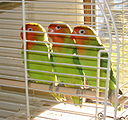 | 13 cm (5 in) long. Mostly green including green back and green rump, orange head, red beak, white eyerings | Malawi |
Black-cheeked Lovebird
(Agapornis nigrigenis) | 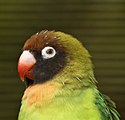 | 14 cm (5.5 in) long. Mostly green, brownish-black cheeks and throat, reddish-brown forehead and forecrown, orange upper chest, red beak, white eyerings | Zambia |
Peach-faced Lovebird
aka Rosy-faced Lovebird
(Agapornis roseicollis) |  | 15 cm (6 in) long. Mostly green, orange face, blue lower back and rump, horn-coloured beak | Namibia, South Africa, Angola |
Abyssinian Lovebird
aka Black-winged Lovebird
(Agapornis taranta) |  | 16.5 cm (6.5 in) long. Mostly green, red beak, some black wing feathers. Sexual dimorphism: only the male has red on forehead and crown, females plumage is all green | southern Eritrea to southwestern Ethiopia |
Red-headed Lovebird
aka Red-faced Lovebird
(Agapornis pullarius) |  | 15 cm (6 in) long. Mostly green with red on upper neck and face. Sexual dimorphism: the male has more extensive and a darker red on face and head, and the male has a darker red beak than the female | Large part of central Africa |
Grey-headed Lovebird
aka Madagascar Lovebird
(Agapornis canus) |  | 13 cm (5 in) long. Mostly green with darker green on back, pale grey beak. Sexual dimorphism: male has a grey upper body, neck and head. | Madagascar |
Black-collared Lovebird
aka Swindern's Lovebird
(Agapornis swindernianus) | 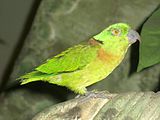 | 13.5 cm (5 in) long. Mostly green, brown collar which has a black upper margin at the back of the neck, dark grey/black beak | Equatorial Africa |
[edit] Feral populations

Hybrids (Fischer's Lovebird x Masked Lovebird) in Nairobi, Kenya.
Feral populations of Fischer's Lovebirds and Masked Lovebirds live in cities of East Africa. Also present there are intergeneric hybrids between these two species. The hybrid has reddish-brown on head and has orange on upper chest, but otherwise resemble the Masked Lovebird.[5]
[edit] Aviculture
Lovebirds have the potential to make fine pets for those who have the patience, space and time required for any parrot species. Because of their inclination to bond, they can form long-term relationships with people in tandem with their intra-species companions. Aggression is easily aroused in lovebirds, however, and biting the hand that feeds them may occur unless a bond is established with gentle handling. Provided with adequate space, a stimulating environment, and appropriate nutrition, a lovebird can become a cherished companion parrot. They love to snuggle and often preen their favorite people.
As with any other pet, it is preferable to obtain birds bred in captivity, rather than birds caught from the wild. Wild birds may be harboring a disease, such as avian polyomavirus.[6] Captured wild lovebirds also may mourn the loss of association with a mate or a flock. Their age is likely to be unknown, and they may have an unsuitable pesonality for domestication. Lovebirds are best kept in pairs, as their name suggests, although relationships with humans are then less likely to be as intense, whereas birds kept individually or brought up hand-fed, make very good pets. However, single birds require frequent attention to stay happy, and if the owner has limited time to spend daily with a single lovebird, it is preferable to grant the lovebird a companion of the same species, or a companion of another parrot species known to get along well with lovebirds. Lovebirds can become very interactive with humans, and when comfortable, will willingly perch on a finger or shoulders.
Some Lovebirds talk, but many will not: there is a chance they may learn to mimic human sounds if taught to do so at a young age. As do most parrots, lovebirds make plenty of noise, with calls ranging from cheerily pleasant to highly irritating; in the wild, parrots must call to each other over long distances to keep flocks together, and it is through such signals that most of their communication is made. Lovebirds may learn to scream if you don't give them attention, but responding to screams will guarantee more of the same. It's best to respond when a call you like is made, but even then, responding every time the preferred call is made can spoil your lovebird. It's best to spend frequent, short periods of time with your lovebird, rather than having just one or two interactions every day.[7]
[edit] Breeding
| | This section may need to be rewritten entirely to comply with Wikipedia's quality standards, as it is too long and appears to be giving instructions. You can help. The discussion page may contain suggestions. (June 2009) |
Determining the sex of your lovebird extremely difficult. When your lovebird reaches maturity, which is around one year of age, it may show some signs of whether it is male or female, such as ripping up paper and stuffing it into its feathers (female behavior) or regurgitating for its owners (male behavior: the male feeds the nesting female). But none of this behavior is a reliable indicator of sex. Females have a larger pelvic space than males, in order to lay eggs, and therefore tend to be "wider in the hips." However, the only sure method is DNA testing. Companies exist that provide such service.[8] The most important thing to consider when deciding to breed lovebirds is how much time and energy you have. Breeding birds need to be in top condition; first of all, they must be supplied a healthy diet with sufficient variety. A good pellet mix, or a high-quality seed mix are at best mere supplements to a wide variety of fresh vegetables, limited fresh fruits, and healthy grains.[9] Note the "Diet" section, below, for a list of foods that present toxicity issues. In general, choose fresh vegetables such as baby carrots (cooked slightly for better assimilation of beta carotene), string beans, squash with yellow or orange flesh, peas, broccoli, zucchini, snow peas, sunflower sprouts, pea shoots, sprouted seeds and beans, (excellent for protein)and fresh (not canned) corn. If your bird is reluctant to try some of these, try sprouting their seed mix. It will be familiar to them and seeds are much healthier when sprouting (lower in fat, higher in amino acids for instance).
Grains: You can sprout many grains at home. Millet and quinoa are two popular grains to sprout. Also, cooked brown rice and cooked quinoa are relished by many parrots, though this should never be a major staple. Quinoa is a South American grain, so parrots from this region probably ate it in the wild. Any food you can duplicate from the natural environment is a candidate, after toxicity issues are understood. Vegetables should always comprise the largest portion of the diet. Fruits should be provided as an occasional treat. Millet sprays should also be limited as a special treat, because some lovebirds will gorge on them. Grapes, cherries, and blueberries are suggested in limited quantities. Use organic fruits only, and wash well. If inorganic fruits and vegetables are used, be sure to wash well to remove contaminants, pesticides, and bacteria.[10]
Lovebirds should not be bred unless they are a year old and sexually mature. Lovebirds sometimes do breed while still immature, but they are likely to be poor parents, or other problems can arise. If a lovebird is provided a mate, and a nesting box, then courtship and mating will result.
Breeding in lovebirds should occur during the warmer months of the year. Most lovebirds require a high humidity in the nest during incubation.
While the female will do most of the work constructing a nest (nesting material must be made available), occasionally the male will assist. Lovebirds need extra moisture during breeding to create eggs, to guarantee good egg development, and then to feed the chicks with liquids and regurgitated food, so plenty of fresh water needs to be provided, along with more fresh fruits and vegetables than usual. All such products should be fresh: remove any scraps daily, to avoid bacterial infections. Check with breeders, your pet store, or your veterinarian concerning vitamin and mineral supplements, such as providing a mineral and salt block, and extra cuttlefish bones for more calcium.
For hatching and proper embryo development, recall that parrots breed in jungle-like conditions, using nesting material high in moisture. Place a mat of moistened peat or well-compressed, moist sphagnum moss in the base of the box. Palm fronds, soaked and washed well, long, or fresh-cut green grasses—cut to varying lengths under 6" long, can suffice. It may be convenient to grow grasses on a windowsill if you cannot cut long grasses from an unmowed section of a yard. Be sure to do research before placing any nesting material inside the cage to check for toxicity. If you cannot find nesting material, check with a pet store or bird breeder for supplies. Never use newspapers or any absorbant material that will dry up the nest or act as a sponge, drawing moisture away from the nesting materials. Depending on the species of lovebird you choose to breed, the female will carry nesting material into the nest in various ways. Peach-face Lovebirds for example, tuck nesting material in their tail feathers while Green Masked Lovebirds carry nesting material back with their beaks.
The nesting box should be deep enough to allow the chicks, after hatching, to always be resting on new layers of fresh material that the parents will continue to bring into the box as the chicks develop. Once the lovebirds start constructing their nest, mating will follow. During this time, the lovebirds will mate repeatedly and you can expect eggs to follow 3–5 days later. The female will spend hours inside her nesting box before eggs are laid. Do not disturb her. Once the first egg is laid, a new egg will follow every other day until the clutch is complete—usually 4 – 6 eggs.
The female will sit on her eggs for 21–23 days, usually receiving much attenntion from the male. Just before hatching, the chicks will make a small crack or hole called a pip hole. This allows them to start breathing oxygen. Not only does it help them breath better, but it is an indication that hatching should follow 12– 24 hours later.
Once the chicks hatch, it is important to avoid touching them. They are very fragile, but the mother will feed and care for them. These first feedings are crucial: the mother will supply her chicks with a clear, nutritious liquid containing digestive enzymes. As the chicks mature, the mother will provide regurgitated material containing more solids. Check with breeders and your veterinarian before attempting to hand-raise or hand-feed any chicks. If you choose to hand feed the chicks, remove them 8–10 days after hatching to begin hand-feeding. Removing one chick at a time will cause the mother to abandon the nest, so if you choose hand feeding, take the entire clutch from the nest at one time, place them into a brooder, and begin the process, making certain that their crops are completely empty before their first feedings, before giving them a formula feed. If you are inexperienced in hand feeding, never try to hand feed chicks without an experienced teacher.
The first few feedings might be difficult; however, most babies eagerly accept feedings. Some breeders choose to spoon feed, while others use a syringe. Whatever method you choose, take caution and be prepared for hours of work. If you choose not to hand feed, but want to interact with the babies daily while their mother feeds them, with patience, the mother should learn to trust your presence, and eventually, you should be able to touch the chicks without upsetting the mother. Place your hand over the chicks at first. Next, remove all the chicks at the same time and held them in your hands for a few minutes with a warm towel under them. Stay close to the cage, allowing the mother to be able to see everything you do: so long as she isn’t frightened and accepts your company, your patience will be rewarded. While the chicks are younger and fewer feathers are present, hold no longer than a few minutes at a time. The babies can easily get cold and weak if they are away from their mother for too long. As the babies mature, handling time can be increased to 15 minutes, three times a day. This method produces tame chicks, and saves you the hard work of hand feeding.
As the chicks grow, they will feather out and start to explore the cage, leaving the nest for longer and longer periods of time, during which they will practice flying, climbing, and exploring objects and toys inside the cage. The mother will encourage them to eat on their own until fully weaned, which occurs at approximately 8 weeks of age. The male Lovebird also helps teach his chicks to eat regular foods.[11] After the chicks are weaned and they have learned to fly, clipping the birds' wings is acceptable and suggested.[citation needed] Clipping the birds’ wings will ensure that your birds don't accidentally escape. The young birds should be removed once they are all independent, for the mother instinctively attempts to drive the young birds away when they are sufficiently mature, in order to be able to nest again. Hence, they must be removed, or the mother could harm them. To rest the breeding pair, remove the nesting box, clean and sterilize it, and place it in storage. Lovebirds produce healthier chicks and have fewer health problems themselves if bred only once a year.[12]
[edit] Housing and environment
Lovebirds require an appropriately sized cage or aviary. Recommended space per bird is min 1m×1m×1m. Lovebird's beaks are made of keratin, which grows continuously. Chewing and destroying wood toys and perches helps to keep beaks trim. Cuttlebones help provide beak-trimming. Natural perches and special rough surfaced perches of varying diameters placed at different levels in the cage will allow greater climbing mobility and gives them a choice to select the most comfortable spot to roost.[13] They also require plenty of toys, such as willow branches, swings, tunnels, boxes and safe things to chew on and play with. Lack of toys, keeping the birdcage covered too many hours, and lack of companionship or social stimulation may lead to boredom, stress and psychological or behavioral problems (nervousness, aggression, feather-plucking, screaming, depression, immuno-suppression). Lovebirds are extremely social birds and will enjoy several hours of interaction a day. Without this interaction, daily exercise, a roomy cage/aviary, and many toys to play with, they may resort to feather-plucking, or screaming, and both behaviors can be difficult to cure. It is suggested that if you must leave the house (to go to work for the day, for example) that you leave a radio or TV set playing, to provide sound..[14] Lovebirds are intelligent, and if a relationship is to form they need a human who will dedicate lots of time with them. It is best to have another lovebird for a companion, preferably of the opposite sex. Lovebirds enjoy baths and like to sun themselves daily.
[edit] Grooming
As with pet parrots in general, the tips of lovebirds' toenails should wear down adequately by the parrot climbing over rough surfaced perches, if the parrot is active; however, occasionally the toe nails grow long and may need to be trimmed.[15] Only the very tips of the toe nails are trimmed, because, if too much of a toe nail is trimmed away, it will be painful and bleed from the blood vessels in the centre of the nail.[15][16] Sharp pointed toe nails that scratch the owner can be blunted by simply filing the point.[16] These procedures are usually done with the help of an assistant carefully holding the parrot wrapped in a towel.[15][16]
- Whole Cereals & whole Grains : Amaranth, Barley, Couscous, Flax, whole-grain Pastas, Oat, Quinoa (truly a Fruit but used as a Cereal), whole-Wheat, Wild-Rice, whole Rices.
- Edible Blossoms & Flowers: Carnations, Chamomille, Chives, Dandelion, Day Lilies, Eucalyptus, Fruit tree's blossoms, Herbs' blossoms, Hibiscus, Honeysuckle, Impatiens, Lilac, Nasturiums, Pansies, Passion Flower (Passiflora), Roses, Sunflowers, Tulips, Violets. Note that the leaves of some of these plants are poisonous to Lovebirds.
- Greens &/or Weeds:
- mainly ; Bok-Choi, Broccoli &/or Cauliflower leaves, Cabbage leaves, Collard greens, Dandelion leaves, Kelp, Mustard leaves, Seaweeds, Spirulina, Water cress...
- occasionally & sporadically ; Amaranth leaves, Beet leaves, Carambola (Starfruit), Chards, Parsley, Spinach & Turnip leaves. All of these feature high Oxalic-Acid contents that induces production of Calcium Oxalates (crystals/stones) by binding Calcium & other trace Minerals present in foods & goods with which they're ingested. Possibly, leading to Calcium deficiencies &/or Hypocalcemia in minor cases. Liver's &/or other internal organs' damage or failure in more severe cases.
- Fruit (except Avocados which are toxic): all Apple varieties (remove all seeds) , fresh Banana, all Berries varieties, all Citrus varieties, Grapes, Kiwi, Mango, Melons, Nectarine, Papaya, Peach, all Pear varieties, Plum, Star-fruit. Pits and seeds from every Citrus and Drupe species must always be discarded as they are intoxicating. However, achenes and tiny seeds from pseudo and true Berries (Bananas, Blueberries, Elderberries, Eggplants, Persimmons, Pomegranates, Raspberries, Strawberries, Tomatoes) are all okay.[17]
- Legumes: Almonds, Beans, Lentils, Peas, Nuts and Tofu.
- Grains' and/or Legumes' SPROUTS: Adzuki beans, Alfalfa beans, Buckwheat, Lentils, Mungo beans, Pinto beans, Red Kidney beans, Sesame seeds, Sunflower seeds. Caution with only Lima and Navy beans' sprouts which are toxic.
- Vegetables (except Uncooked Potatoes, Uncooked Onions and all Mushrooms): Beet, Broccoli, Cauliflower, Carrots, Cucumber, all Cabbage varieties, fresh Beans, fresh Romane Lettuce, fresh Peas, Parsnip, all Pepper varieties, all Squash varieties, Sweet potatoes, Tomato, Turnip, Yams, Zucchini.
- Pellets specifically formulated for Lovebirds and/or for small parrots are all healthy additions.
- Other fat-free, healthy and nutritious human foods in very limited amounts.
Adding these foods provides additional nutrients and can prevent obesity and lipomas, as can substituting millet, which is relatively low in fat, for higher-fat seed mixes. Adult Lovebirds often do not always adapt readily to dietary additions, so care must be taken to introduce healthy diets as young as possible (ideally weaned onto fresh foods before introducing chicks onto seeds). Lovebirds like any other Parrots learn mainly by mimicry and thus most adult Lovebirds will be easily encouraged to try new foods by observing another bird eating the food, or by placing the new food on a mirror.
Parrot species (including Cockatiels) are biologically vegetarian species. Consequently, they should be fed vegetarian diets that are ideally supplemented with vegetable proteins provided by the combination of any type of whole Grain/Cereal with any type of Legume/Pulse. Eggs (hard-boiled and/or scrambled) are the only one appropriately healthy source of animal proteins. Mostly for Birds in either breeding, growing, moulting and/or recovering conditions. High levels of Proteins (most particularly Animal Proteins) is unhealthy for Lovebirds living under any alternate conditions (i.e. non-breeding, pets...)
Intermediate species such as African Grey Parrots, LoveBirds, Poicephalus, RingNecked Parakeets... should be offered diets where pellets represent a moderate portion of about 1/3 to 1/2 of their daily diets.
In terms of health, if you want to be a pet owner, the least you can do is ensure the animal has plenty of exercise and freedom. If one does not have the space, one should not take these animals on.

Green and Blue series Peach-faced Lovebirds:
two parents with their two recently fledged chicks
[edit] Aggression problems with other birds and animal species
Because of their dominant nature, Lovebirds should be supervised when socializing with other species/genera (whether it be cat, dog, small mammal or other bird species). Lovebirds can be aggressive to other birds. Hand raised Lovebirds tend not to be scared and pose even more of a threat to themselves. Toe biting can occur when Lovebirds are socializing/housed with small birds (ie. Parrotlets, Budgies, and even docile Cockatiels). They should not be housed with other bird genera as they can be injured or pose a threat to other birds.
Lovebirds are very vocal birds, making loud, high-pitched noises. Some make noise all day, especially during the first morning hours.
Lovebirds are also very active and love to chew things. When they are flying within a household, it is wise to watch them carefully and protect any furniture, electrical wiring or anything else that they could possibly chew on. Try to place fresh willow or oak branches in a favorite spot (eg near a high/sunny platform) to satisfy this natural behavior.
Lovebirds of different species can mate and produce sterile hybrid offspring. These offspring display habits of both parents. It is recommended to only place birds of the same species together, or of the same sex for this reason.
[edit] In popular culture
Songs about lovebirds include:
[edit] Further reading
- All About Breeding Lovebirds (Hardcover) by Mervin Roberts
- Lovebirds: Everything About Housing, Care, Nutrition, Breeding, and Diseases With a Special Chapter, "Understanding Lovebirds" (A Complete Pet Owner's Manual) by Matthew M. Vriends
[edit] References
- ^ Alderton, David (2003). The ultimate encyclopedia of caged and aviary birds. London, England: Hermes House. pp. 216–219. ISBN 184309164X.
- ^ a b c Le Breton, Kenny. Lovebirds...getting started. USA: T.F.H. Publictions. p. 84–98. ISBN 0866224114.
- ^ Eberhard, Jessica R. (1998): Evolution of nest-building behavior in Agapornis parrots. The Auk 115(2):455-464.
- ^ "Zoological Nomenclature Resource: Psittaciformes (Version 9.004)". www.zoonomen.net. 2008-07-05. http://www.zoonomen.net/avtax/psit.html.
- ^ Forshaw (2006). plate 45.
- ^ Johne, R. Müller, H. "Avian polyomavirus in wild birds : genome analysis of isolates from Falconiformes and Psittaciformes Auteur(s") Archives of virology ISSN 0304-8608; 1998, vol. 143, no8, pp. 1501-1512
- ^ ParrotParrot "What's that Noise? http://www.parrotparrot.com/articles/aa053001.htm
- ^ LovebirdMania.com "Lovebirds-- Female versus Male" http://www.lovebirds.co.nz/choosing/vs.php
- ^ ParrotParrot.com "Breeding Lovebirds" http://www.parrotparrot.com/lovebirds/breeding.htm
- ^ ParrotParrot.com "Nutrition and Diet" http://www.parrotparrot.com/birdhealth/
- ^ The Pet Bird Lovebird FAQ: "The Lovebird FAQ by Nicole Jones "http://www.upatsix.com/faq/lvbrdfaq.htm
- ^ Parrotfeathers.com "Breeding Behavior" http://www.parrotfeather.com/lovebird/breeding_lovebirds.php
- ^ Johnson, Anne "Lovebirds" Birds and Ways, Pet Bird Magazine, Ezine January 1998 http://www.birdsnways.com/wisdom/ww19eiii.htm
- ^ Parrotfeather.com: "Lovebird problems" http://www.parrotfeather.com/lovebird/Lovebird_problems.php
- ^ a b c De Saulles, Annette; Forbes, Neil (2003). Parrotlopaedia: a Complete Guide to Parrot Care. Ringpress Books. p. 73. ISBN 1860542859.
- ^ a b c Low, Rosemary (1999). The Loving Care of Pet Parrots. Hancock House. pp. 167–168. ISBN 088839439.
- ^ PetEducation.com "Bird Nutrition: Feeding Pet Birds, Parrot Diets, and Nutrition Recommendations" http://www.peteducation.com/article.cfm?c=15+1835&aid=2844
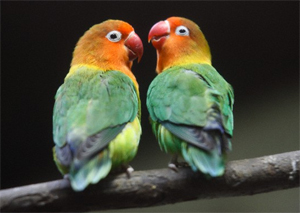
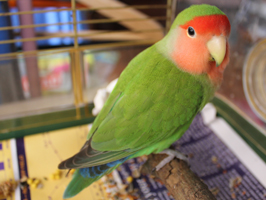
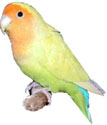


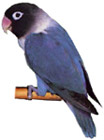

 It is important to realize that while lovebirds are a small parrot, they have the intelligence and abilities of some of the largest parrots. They can amaze you with their ability to escape their own cages (I have to put clips on the cage doors to keep them in, and sometimes they figure out how to open those!), they will sometimes try to become the little bosses of the household (hence, the same type of
It is important to realize that while lovebirds are a small parrot, they have the intelligence and abilities of some of the largest parrots. They can amaze you with their ability to escape their own cages (I have to put clips on the cage doors to keep them in, and sometimes they figure out how to open those!), they will sometimes try to become the little bosses of the household (hence, the same type of 














